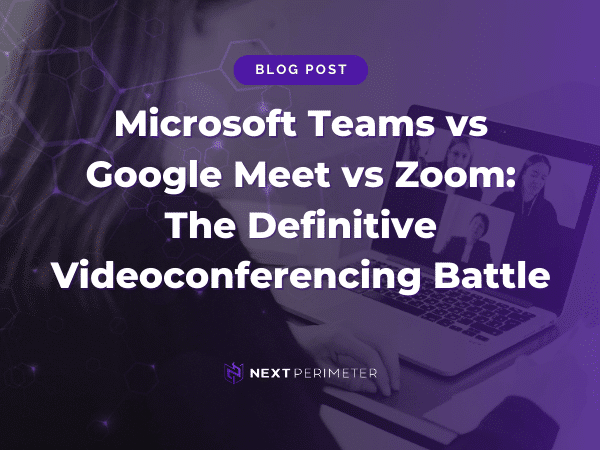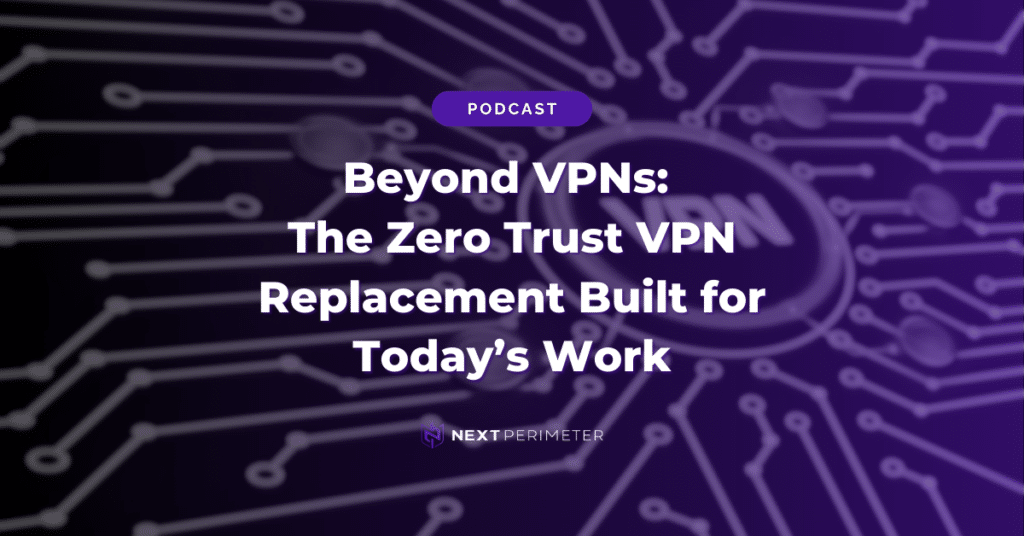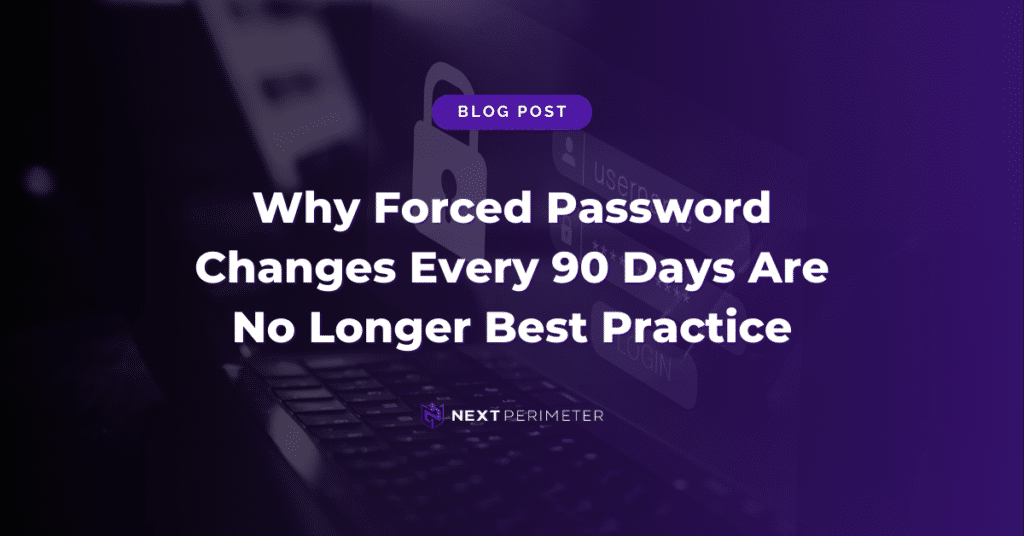The COVID-19 pandemic forced employees to work from home, but the show had to go on somehow. Overnight, videoconferencing platforms turned into the lifeline that held businesses together. Even as operations return to normal, videoconferencing providers are pouring resources into their products.
The two main collaboration suites, Microsoft 365 and Google Workspace offer videoconferencing capabilities, but we would be remiss not to include one of the most popular videoconferencing apps in the market today – Zoom.
At this point, your business is almost guaranteed to have a videoconferencing platform already. If not, or if you are looking to change platforms, continue reading below for a breakdown of features and options that will help you make your decision.
Are your meetings long or short? Are you mostly meeting internally or with leads and clients? Will you be hosting webinars?
It goes without saying, if your company is already subscribed to Microsoft 365 or Google Workspace, and you are happy with the platform, you should use Teams or Meet respectively. If you are not subscribed to either and simply need a standalone videoconferencing app, Zoom has a free version that should solve most of your needs.
In the sections below, we will compare all three major videoconferencing platforms based on various metrics you should consider before choosing the right one for your business.
Table of Contents
Teams vs Meet vs Zoom: Integration with your other apps/services
Before diving into the full list of features for each platform, it is important to understand how much you get from the entirety of what you are paying for.
Teams and Meet are part of larger productivity suites, whereas Zoom is a standalone product with all the videoconferencing-specific features you may need. While Teams and Meet can be procured independently, they are best bundled with their larger suites, Microsoft 365 and Google Workspace.
Case in point, a Zoom Pro subscription only gives you videoconferencing capabilities. For less than Zoom Pro, the M365 Business Standard and Workspace Business subscriptions include a full suite of business applications.
With Microsoft 365, you get a fully integrated experience with desktop versions of Word, Excel, PowerPoint, and more. The biggest selling point of Microsoft is how easily the apps work with each other, and the biggest difference between Teams and its competitors is how centralized the suite is.
Teams jumps seamlessly from instant messaging to video calls, with the ability to switch back and forth between them.
Meanwhile, Google Meet is independent of Workspace’s chat app, Google Chat. While users can utilize both Workspace apps simultaneously, the separation of the two is a bit counterintuitive.
With M365 and Teams, all chats, recorded meetings, and files are all housed in the same central location, making searchability far easier.
With Meet and Zoom, you will have to seek out saved chats from old meetings, or in the case of Meet, head over to Google Chat.
This is also the case when working on collaborative files. Any files attached in a Teams chat will appear under its files tab at the top of the window, meaning you don’t have to waste time chasing them down when you need them.
Microsoft offers even more applications in their plans than Google, though many go unnoticed.
For example, Microsoft Sway allows you to quickly grab and trim a recorded Teams meeting that you can then house locally within Teams itself.
In the case that someone arrives late to a meeting, or an employee records the same meeting and lets it run for hours after its conclusion, you can quickly grab the part of the meeting you need and save it.
This bypasses the storage that would be eaten up by an hours-long video clip, as well as the time it would take to upload, trim, and export said video from a video editing platform.
Additionally, all three platforms do have integrations with various other business applications, so be sure to check on compatibility with any apps you already use, and these platforms.
Teams vs Meet vs Zoom: Features
Comparing Free Versions vs. Paid
Microsoft, Google, and Zoom have all adapted well to the demand for certain features on their platforms, thus most of the same features overlap across plans for all three suites. This includes screen sharing, video recording, live captions, and everyone’s favorite: custom backgrounds. As for some other features, they vary across each company’s offerings.
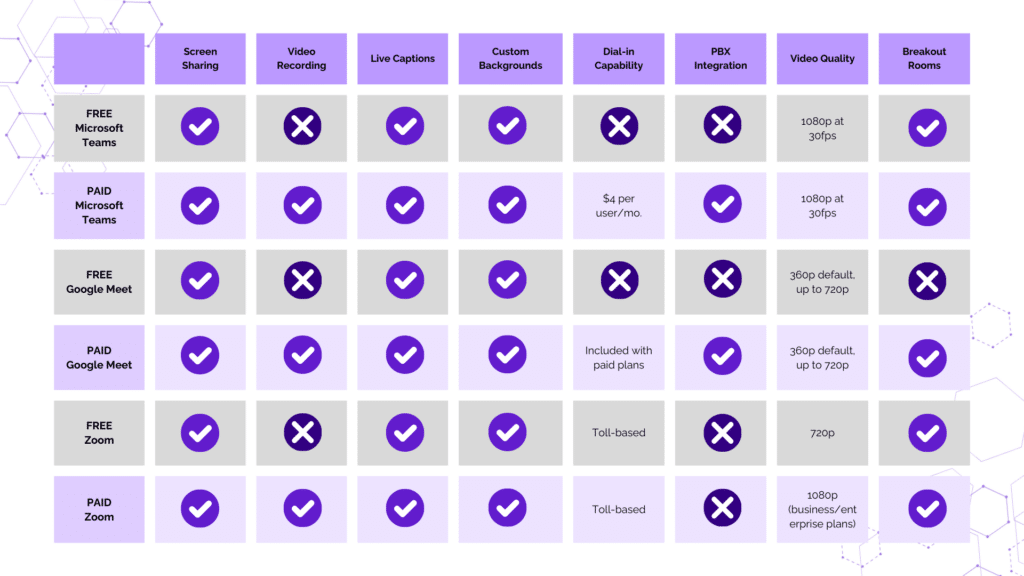
Audio Conferencing On-the-Go
While present across the board, dial-in capabilities vary across plans. Meet offers dial-in for free with any of their paid plans, one of the biggest advantages that the platform has over its competitors.
Teams offers its dial-in capability for $4 extra per user, per month; while Zoom’s dial-in is toll-based.
Both Teams and Meet offer internet-based PBX solutions that can replace your in-house phones, while Zoom’s toll-based setup is not practical.
Microsoft 365 Business Voice integrates seamlessly with Teams, allowing employees to take business on the go, all with full continuity.
Video Quality – Who Supports the Best?
As of the time of this post, each platform displays video in HD, but the quality varies. Teams is capable of 1080p video at 30 frames per second if you have 1.5 Mbps of bandwidth.
Zoom also has 1080p video, but it is limited to the platform’s business or enterprise plans. 1080p can also be enabled by Zoom support in certain cases. Zoom’s 1080p functionality requires 1.8 Mbps of bandwidth for 1-on-1 calls and 2.5 Mbps on group calls.
Meet will default to 360p video, but it can send and receive up to 720p video.
Audio quality across platforms depends on microphone and speaker quality, as well as the quality of your internet connection.
Rooms and Workspaces – Breaking Things Down
Breakout rooms are essentially meetings that run simultaneously to the original videoconference. These were especially necessary for virtual education, so teachers could break students out into separate groups to learn.
There is a clear utility for breakout rooms in professional spaces, too. If a larger team is meeting about a project, breaking down tasks into smaller groups, breakout rooms could be a great solution.
Both Teams and Zoom have breakout rooms native to their base platforms, across all plans. These rooms are essentially meetings that are running simultaneously to the original videoconference.
Meet allows breakout rooms through their standard and plus plans, but not in the free or basic plans. However, like most Google functions on cheaper plans, you can add Google Chrome extensions, but this could be more of a headache than it is worth in the end.
Recently, Microsoft also rolled out Together Mode, which uses AI to place video participants in various digital settings, together. While the utility is light, Together Mode could be a solid morale booster.
Teams vs Meet vs Zoom: Privacy and Safety
To its credit, Zoom responded swiftly to the “Zoom bombing” of the early days of the pandemic, adding end-to-end encryption and beefing up their privacy policy. Unfortunately, over 500,000 Zoom accounts were stolen and posted for sale online soon thereafter.
While Meet has not had any famous incidents of privacy breaches, Google has had plenty of privacy concerns and a track record of collecting data for use in advertising.
Microsoft has the best track record of security and they also have the most transparent privacy policy.
All three platforms support two-factor authentication. Considering that 99% of cybersecurity attacks involve a password element, two-factor authentication is a must if you want a legitimate defense against cybercriminals.
As a part of the wider M365 suite, all chats, notes, and files are encrypted and stored within OneNote and SharePoint, respectively.
Additionally, Microsoft Advanced Threat Protection (ATP) is available on its Business Premium and E5 plans, blocking potentially malicious content from being accessed by those in your company.
Microsoft also uses Data Loss Protection (DLP) to catch sensitive data being shared (like social security numbers), and automatically block it from being sent.
Along with eDiscovery and legal holds within channels, chats, and files, Teams ensures you stay compliant with all data storage regulations.
Google does offer eDiscovery in their Business and Enterprise plans and DLP in their Enterprise plan only, but these are only limited to Drive and Gmail. From what we can see Meet has no specifically listed DLP capabilities.
Zoom does not offer any of these features on its primary platform.
Overall, Zoom has responded well to its privacy challenges, but the changes are largely cosmetic.
End-to-end encryption (E2EE) is great to have, but its addition was more of a response to a problem than a complete solution. It is unlikely that E2EE protects most users from more than encryption in transit and at rest, like with Teams and Meet.
E2EE is most useful in 1-on-1 conversations where sensitive information may be shared, and it will be available on Teams soon according to Microsoft.
The videoconferencing company has less to worry about because they are a single-purpose app, dealing solely with videoconferencing, and not the storage of files, chats, and other information like Microsoft or Google.
Based on reputation alone, Microsoft stands well above the others in terms of security.
Because your data is all stored in a single space, Teams and its security features take your productivity hub and turns it into your company’s own data stronghold. This second level of protection and privacy makes it the safest, in our experience.
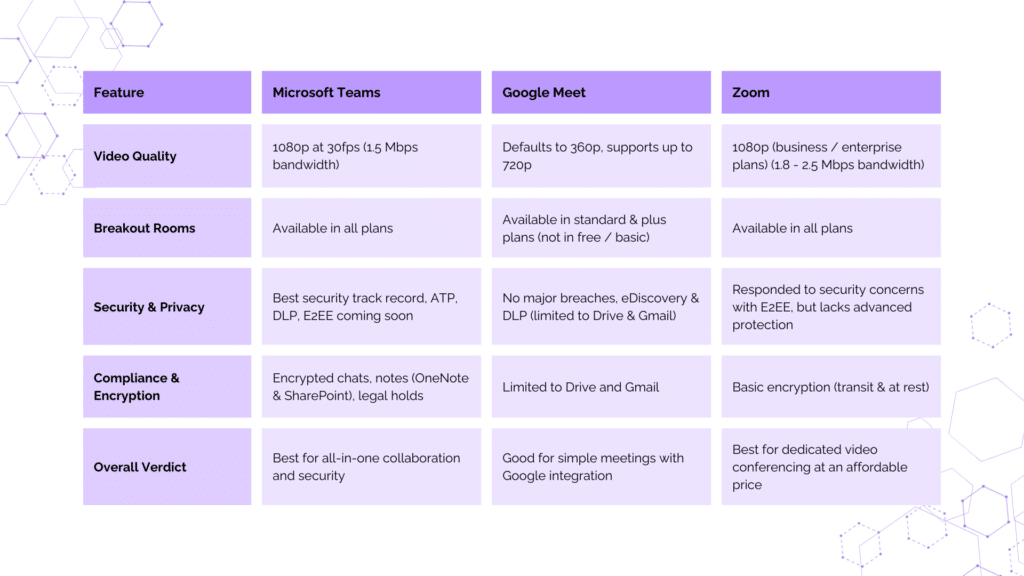
Teams vs Meet vs Zoom: The Verdict
Though most videoconferencing platforms have similar features, your business’s exact needs should determine whether you choose Microsoft Teams, Google Meet, or Zoom.
For base-level features at an affordable price, it is hard to beat Zoom, who is focused solely on videoconferencing. For the most bang for your buck, Teams ties your whole company together in one space, with the best possible features and security available.
If you are looking for an all-in-one collaboration hub that keeps all your communication in one space, we highly recommend Microsoft Teams.
Next Perimeter has leveraged the power of Microsoft 365 since 2008 when it was still called Business Productivity Online Suite (BPOS), and we have continued our partnership until the present day.
Next Perimeter can get your business firing on all cylinders with Microsoft Teams and M365 by giving us a call today at 888-286-4816.

